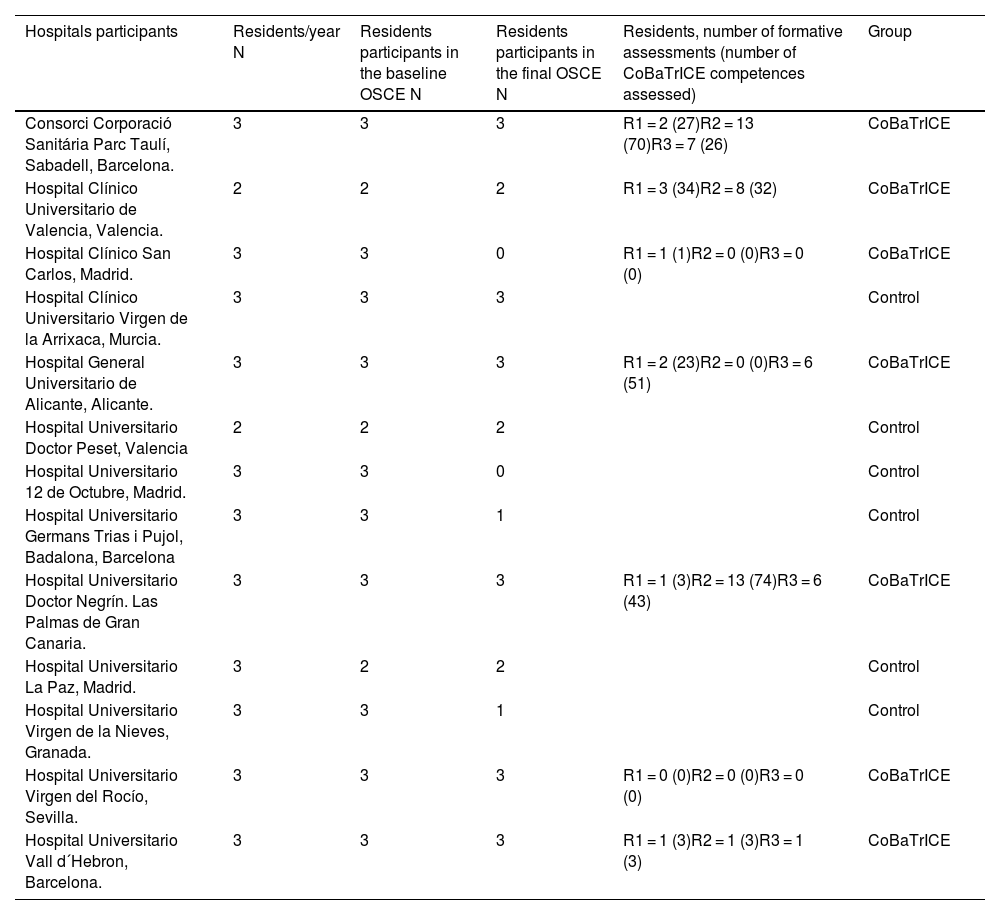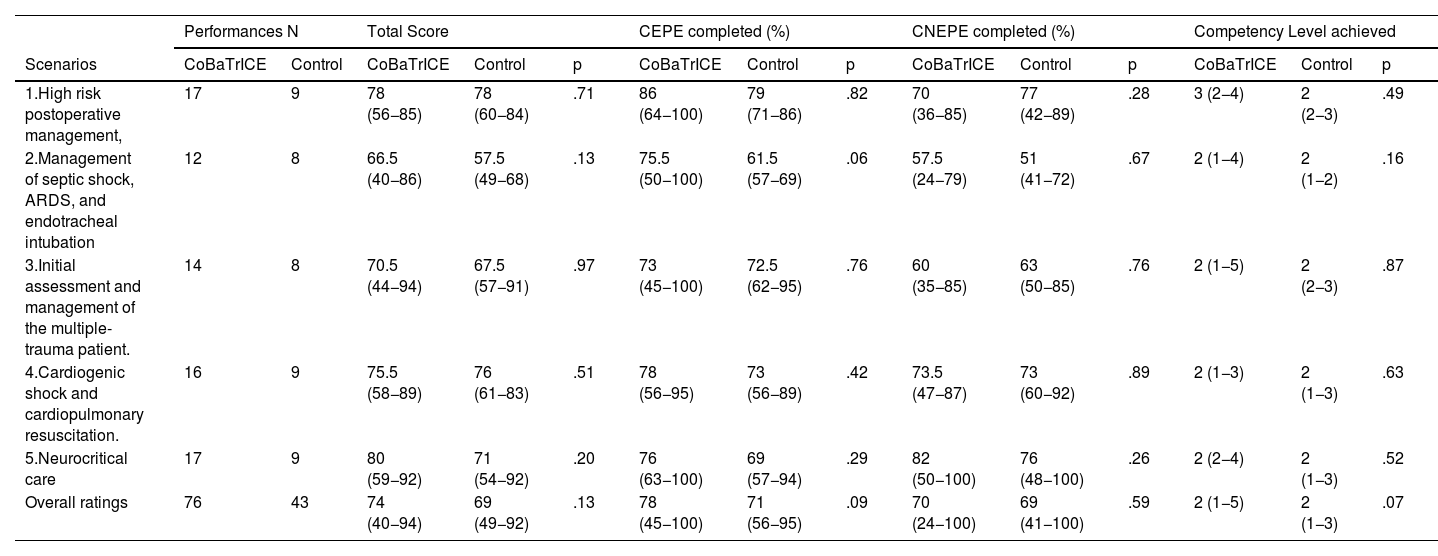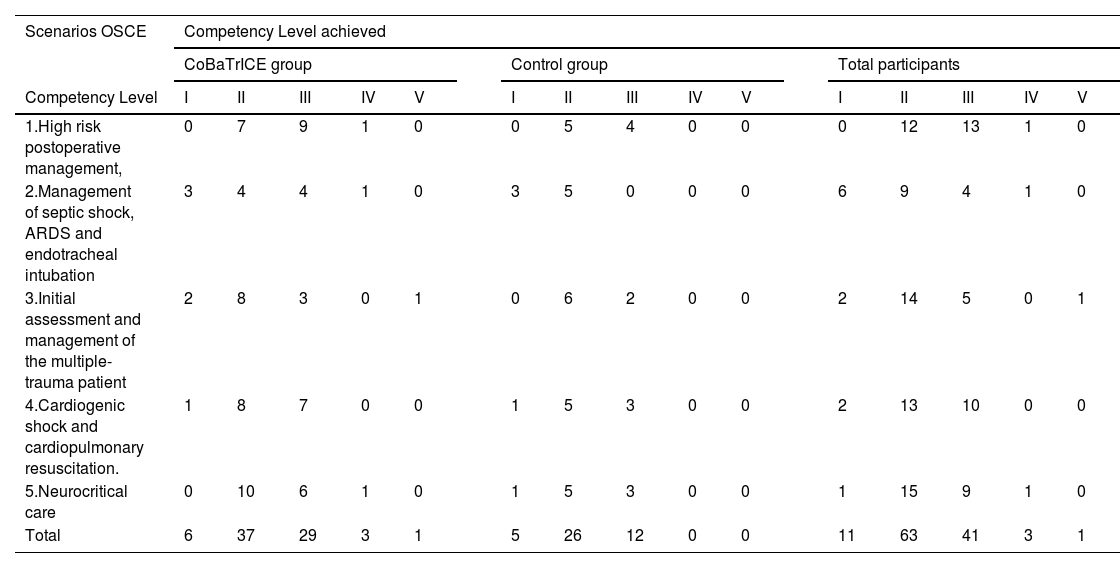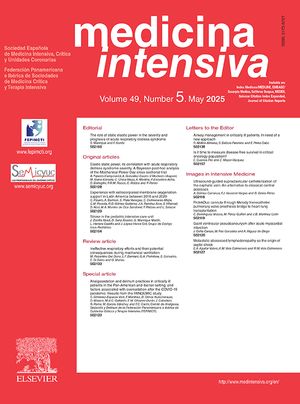The main objective of this study was to evaluate whether the implementation of CoBaTrICE (Competency-Based Training in Intensive Care Medicine in Europe) provides higher levels of competency in comparison with the current official time-based program in Intensive Care Medicine in Spain. Secondary objectives were: 1) To determine the percentage of critical essential performance elements (CEPE) accomplished, 2) To determine compliance with workplace-based assessments (wba).
DesignMulticenter cluster randomized trial.
SettingThirteen Spanish ICU Departments.
ParticipantsThirty-six residents
InterventionThe implementation of CoBaTrICE included: (1) Training the trainers; (2) Wba; (3) The use of an electronic portfolio. The level of competency achieved by each participant was determined by a simulation-based Objective Structured Clinical Exam (OSCE) performed at the end of the 5th year of training period.
Main variables of interestTotal scoring in the five scenarios, CEPE completed, level of competency (1–5) achieved.
ResultsA total of 119 performances from 26 residents (17 from CoBaTrICE group and 9 from control group) were analyzed in the OSCE. CoBaTrICE residents´ achieved higher levels of competency [2 (1−5) vs. 2 (1−3), p = 0.07) and higher percentages of CEPE´s accomplishment than the control group (78% vs. 71%, p = 0.09).
ConclusionsThe CoBaTrICE group showed a better performance trend in comparison to the control group, but the differences were not statistically significant. Since the number of Wba performed was low, additional research is needed to determine the potential superiority of CoBaTrICE.
El objetivo principal del estudio fue evaluar si la implementación de CoBaTrICE (Competency-Based Training in Intensive Care Medicine in Europe) proporciona niveles de competencia superiores al programa oficial español actual de medicina intensiva basado en rotaciones. Objetivos secundarios: 1) determinar la proporción de elementos críticos de desempeño esenciales (CEPE) completados, 2) determinar el cumplimiento de CoBaTrICE.
DiseñoEnsayo multicéntrico aleatorio de tipo conglomerado.
ÁmbitoTrece departamentos de medicina intensiva españoles.
ParticipantesTreinta y seis residentes.
IntervenciónLa implementación de CoBaTrICE incluyó: (1) curso de feedback para tutores; (2) realización de evaluaciones formativas en la UCI; (3) uso de un portafolio electrónico. El nivel de competencia de cada participante se determinó mediante un examen clínico objetivo estructurado (ECOE) basado en simulación realizado al final de la residencia.
Principales variables de interésPuntuación total en los cinco escenarios, CEPE completadas, nivel de competencia alcanzado (1 a 5).
ResultadosSe analizaron un total de 119 actuaciones de 26 residentes (17 del grupo CoBaTrICE y 9 del grupo control). Los residentes de CoBaTrICE consiguieron niveles más altos de competencia [2 (1–5) vs. 2 (1–3), p = 0,07] y mayores porcentajes de CEPE que el grupo control (78% vs. 71%, p = 0,09).
ConclusionesEl grupo CoBaTrICE mostró una tendencia a un mejor desempeño que el grupo control, pero las diferencias no fueron estadísticamente significativas. Dado que el número de evaluaciones realizadas fue muy bajo, se necesita investigación adicional para determinar la posible superioridad de CoBaTrICE.
Article
Go to the members area of the website of the SEMICYUC (www.semicyuc.org )and click the link to the magazine.










